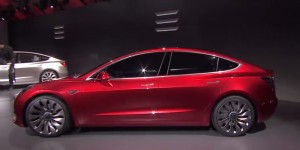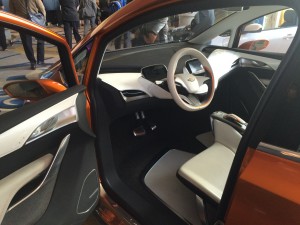Tesla’s first mass-market vehicle, the Model 3, continues to be plagued by quality control issues. Charved EVs magazine covered the recent purchase and teardown of two Model 3 copies by Sandy Munro of Munro & Associates, a Detroit consulting firm which dismantles cars and analyzes them in painstaking detail for auto-industry clients. The results were not pretty on some basic manufacturing issues:
As others have, Munro found that Model 3 suffers from poor build quality – panels that don’t line up properly, and in one case, a door liner that seems to have been installed backwards. He also claims to have received “hundreds, maybe a thousand” emails from owners complaining about similar fit-and-finish issues. He surmises that the problems stem from poorly trained assembly line workers and (as others have noted, and Elon Musk has admitted) too much and too-hasty automation.
But the news was not all bad, particularly with Munro’s glowing account of the Model 3’s electronics and battery technology. He compared the circuit board to the “kind of technology you’d find in military-grade hardware.”
Munro also heaped praise on the Tesla battery pack, noting its high power density, superb build quality and minimal current differential between cells. “Nobody can balance batteries that close. Nobody. Nobody’s ever done that.” Munro says that Korean suppliers LG and Samsung have long been considered the best in the battery business, but that the Model 3 pack “blows them both away.”
The positive reviews in some ways underscore the frustration with the quality control challenges. Tesla’s survival as a company will depend on its ability to right this ship, as a poor reputation on quality could sink sales (and a new Bloomberg report indicates that the company could possibly run out of cash later this year, as it reportedly spends more than $6,500 every minute). While the company has thrived by bucking tradition on almost every facet of the automaker industry, its efforts to reinvent manufacturing may have been a step too far.
For more information, check out the in-depth video of Munro’s teardown above.
Halloween may be over, but the climate frights this week continue. Here are the scary highlights:
- Electric vehicle incentives in trouble: the Republican tax plan would eliminate the $7500 tax credit for EV purchases, which would likely torpedo sales for all but the luxury EVs in the short term. States might be able to dig deep to make up some of the difference, and the tax credit is set to phase out anyway for automakers over certain sales amounts, but nonetheless this would be a big blow to demand.
- Infill tax credits at risk: the Republican tax plan also targets federal programs that help revitalize infill neighborhoods. It would eliminate key programs like New Markets Tax Credits (NMTC), Historic Preservation Tax Credits (HTC), and the Community Development Block Grant (CDBG) program. As Smart Growth America and their infill group Locus writes in a newsletter today, “community development projects almost invariably rely on federal programs like these to fill a critical financing gap, often making the difference between a go and a no-go decision for a project penciling out.”
- Tesla Model 3 stuck in production “hell”: Tesla’s third-quarter earnings call brought bad news about the Model 3, the $35,000 mass-market EV that is struggling to meet its production targets. The company’s goal of producing 5,000 units a week by the end of 2017 has slid to the first quarter of 2018. The normally upbeat Elon Musk was apparently in a bad mood, per E&E News [paywalled]:
The call’s tone was a swing to the dark side for Musk, who on quarterly earnings calls often minimizes problems and instead trumpets the company’s successes, or announces or at least hints at some bold new initiative.
- Earth passes a carbon milestone: scientists report that the rate of carbon dioxide being released into the atmosphere accelerated at an unprecedented pace last year, reaching levels not seen in 800,000 years. Per E&E news [paywalled]:
Current levels of CO2 correspond to the Pliocene period from 3 million to 5 million years ago, when the climate was 3.5 to 5.5 degrees Fahrenheit warmer, the report found. At that time, the ice sheets of Greenland and West Antarctica were melted. Sea levels were 30-60 feet higher than they are now.
I’d say this is not a good time to invest in ocean-front property. Happy Frightful Friday!
Good news from Tesla about the country’s independence — from petroleum as the primary transportation fuel, per the San Francisco Chronicle:
Electric auto maker Tesla plans to deliver the first of its long-awaited $35,000 Model 3 sedans on July 28th and expects to build 20,000 of the cars per month by the end of the year, CEO Elon Musk revealed late Sunday.
The company aims to produce 100 cars in August, 1,500 in September, and 20,000 in December.
The  advent of this car on the market means there will now be two EVs that can go over 200 miles on a single charge at less than $40,000 (really closer to $30,000 with incentives): the Chevy Bolt and now the Model 3. Those prices aren’t cheap, but they aren’t expensive either, especially when considering the low maintenance and fuel costs (at least if you fuel at home in your garage).
advent of this car on the market means there will now be two EVs that can go over 200 miles on a single charge at less than $40,000 (really closer to $30,000 with incentives): the Chevy Bolt and now the Model 3. Those prices aren’t cheap, but they aren’t expensive either, especially when considering the low maintenance and fuel costs (at least if you fuel at home in your garage).
The big question to me will be reliability: the Models S and X from Tesla have had a lot of quality control problems for drivers. Those high-end consumers tend to be okay with the hassle. But with the Model 3, consumers won’t be as forgiving if the car has to be in the shop a lot for small fixes.
And the second question: will Tesla actually be able to achieve its production targets? It’s a good sign that the company is two weeks early with the start of production, but historically they’ve had challenges getting their manufacturing and supply chains together.
This model will truly be a make-or-break test for the company, if it’s to fulfill the vision of becoming a major global automaker and bring EVs to dominance.
Tesla has all the hype and fandom, but Chevy is on pace to actually get it done. The “it” in question is developing a 200-mile range electric vehicle for under $40,000. The higher-mile range at that price is an important threshold for convincing average drivers to go electric with their next purchase.
The Chevy Bolt will feature a 60 kwh battery, and most people assumed that meant a range close to 200 miles, like Tesla’s Model 3. But Chevy just announced the vehicle will in fact have a rated range of 238 miles, compared to the Model 3’s 215 mile rated range.
And even more importantly, the vehicle will be on sale at the end of this year, compared to next year for the Model 3 (if that — given past history of delays, I would expect Tesla to deliver the vehicles in 2018, more likely).
To be sure, the Bolt won’t have a lot of the pizzazz of the Model 3, but it looks to be a solid car that could finally meet most, if not all, of people’s driving needs. Particularly with fast-chargers being deployed at a more rapid clip for long-range trips.
More importantly, it will help solidify consumer demand and industry commitment to driving electric. The future for this technology is bright, and I look forward to a day where air pollution from petroleum-fueled vehicles is a thing of the past.
The Tesla Model 3 got a lot of hype and pre-release deposits, but Chevy may quietly beat Tesla in bringing a 200-mile range electric vehicle under $40,000 to market. The new Bolt will supposedly be in production next year, and Car and Driver magazine just reviewed the prototype car with the Bolt’s chief engineer Josh Tavel:
Tavel is still tweaking various calibrations since Bolt production and sales are months out, but he’s clearly proud of what his development team has achieved. This 37-year-old engineer began amateur competition at age five on BMX bikes and continued with minimal interruption to his current SCCA Spec Racer Ford campaign. A deeply ingrained racing mentality may be why Tavel hated to sacrifice any torque to diminish tugs on the steering wheel, and why the Bolt’s every motion is well managed when you toss it around. Without imposing harshness, the ride is firm to help keep body roll in check during full-boogie maneuvers. The low-rolling-resistance Michelin Energy Saver A/S 215/50R-17 tires absorb patched pavement without recoil and break away gently when tasked with a surprise lane change.
The review is overall very positive, although it notes some of the flaws related to slow charging and driving experience, when compared to the new Tesla.
Still, at the right price and with dependability that Tesla may struggle to offer, this car could put electric vehicles on the map for average consumers in a big way.
With all the hype around Tesla’s Model 3, it’s easy to forget that Chevy is probably the first in line to deliver a 200-mile range electric vehicle for under $40,000. Now Motor Trend has the geeky details on the car:
The 60-kW-hr battery pack was co-developed with and is fully assembled by LG Chem in Korea. It employs 288 prismatic pouch cells (each 3.9 inches tall by 13.1 inches wide) that are curiously packaged in pairs but wired in three-cell groups. Their chemistry is similar to that used on the Spark EV but with a bit more nickel content to allow it to operate at a slightly higher temperature. The whole setup is considerably different from that of the extended-range Volt, as the Bolt requires energy-storage optimization whereas the Volt needs a balance between power delivery and energy storage. Capitalizing on copious lessons learned in the second-gen Volt and Spark EV, this battery holds more than triple the energy of the Spark EV battery pack (60.0 versus 18.4 kW-hrs) but weighs just over twice as much (961 versus 474 pounds).
The bottom line: the car will get you about the same range as the Model 3, but for probably a lot less money. This is because Chevy should still have enough $7500 federal tax credits to offer purchasers, whereas Tesla will have exhausted theirs by the time the Model 3 comes out.
But the performance of the Bolt will be nothing near a Model 3, as dual motor drive and therefore fast acceleration look to be impossible with the current Bolt battery configuration. In addition, the Bolt won’t have the fast-charge speed that Tesla offers, with about 90 mile range in 30 minutes being the best you could hope for. By comparison, Tesla offers 170 miles of range in the same charging time frame with their Supercharger network. So road trips will be slow in this vehicle.
Still, if range and price is what you care about, and not so much on performance, this vehicle will be a good option — and it should be available a lot sooner than the notoriously late Tesla.



